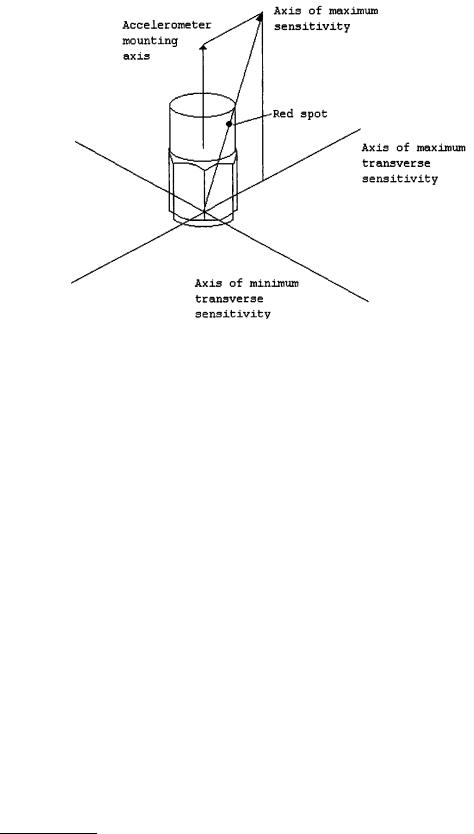
- •17.1 Accelerometer Dynamics: Frequency Response, Damping, Damping Ratio, and Linearity
- •Periodic Vibrations
- •Stationary Random Vibrations
- •Transients and Shocks
- •Nonstationary Random Vibrations
- •Coil-and-Magnetic Type Accelerometers
- •Induction Type Accelerometers
- •17.3 Piezoelectric Accelerometers
- •17.4 Piezoresistive Accelerometers
- •17.5 Differential-Capacitance Accelerometers
- •17.6 Strain-Gage Accelerometers
- •17.7 Seismic Accelerometers
- •17.9 Electrostatic Force Feedback Accelerometers
- •17.10 Microaccelerometers
- •The Frequency Range
- •The Sensitivity, Mass, and Dynamic Range
- •The Transient Response
- •Full-Scale Range and Overload Capability
- •Environmental Conditions
- •17.13 Signal Conditioning
- •Signal Conditioning Piezoelectric Accelerometers
- •Signal Conditioning of Piezoresistive Transducers
- •Microaccelerometers
- •References
- •List of Manufacturers

FIGURE 17.19 Vectorial illustration of cross-axis sensitivity. Accelerometers may sense vibrations not only in the direction of main axis, but also perpendicular to the main axis. These cross-axis responses are minimized in many accelerometers to a value less than 1%. Sometimes, this sensitivity is used to determine the correct orientation of the device.
The Frequency Range
Acceleration measurements are normally confined to using the linear portion of the response curve. The response is limited at the low frequencies as well as at the high frequencies by the natural resonances. As a rule of thumb, the upper frequency limit for the measurement can be set to one third of the accelerometer’s resonance frequency such that the vibrations measured will be less than 1 dB in linearity. It should be noted that an accelerometer’s useful frequency range is significantly higher, that is, to 1/2 or 2/3 of its resonant frequency. The measurement frequencies may be set to higher values in applications where lower linearity (e.g., 3 dB) may be acceptable, as in the case of monitoring internal conditions of machines since the reputability is more important than the linearity. The lower measuring frequency limit is determined by two factors. The first is the low-frequency cut-off of the associated preamplifiers. The second is the effect of ambient temperature fluctuations to which the accelerometer could be sensitive.
The Sensitivity, Mass, and Dynamic Range
Ideally, the higher the transducer sensitivity, the better; but compromises might have to be made for sensitivity versus frequency, range, overload capacity, and size.
Accelerometer mass becomes important when using it on small and light test objects. The accelerometer should not load the structural member, since additional mass can significantly change the levels and frequency presence at measuring points and invalidate the results. As a general rule, the accelerometer mass should not be greater than one tenth the effective mass of the part or the structure that is mounted onto for measurements.
The dynamic range of the accelerometer should match the high or low acceleration levels of the measured objects. General-purpose accelerometers can be linear up to 5000 g to 10,000 g, which is well into the range of most mechanical shocks. Special accelerometers can measure up to 100,000 g.
© 1999 by CRC Press LLC
